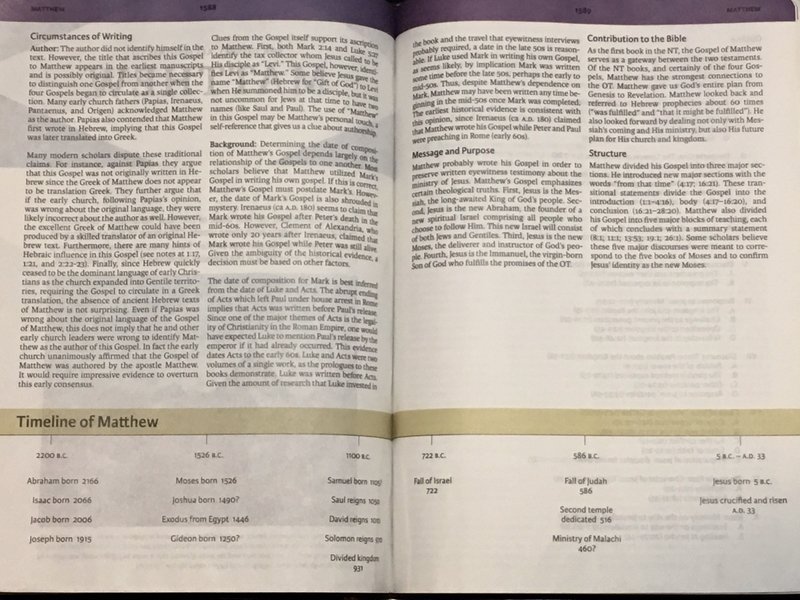 “You need to read your Bible.”
“You need to read your Bible.”
That blanket statement is one of the most frustrating things in the Church today.
No, not because reading the Bible is a bad thing, but because we neglect the skills needed for beginners to do so.
From my experience, people’s willingness to read the Word isn’t the problem. The biggest issue they face, is “how?”.
The Bible isn’t exactly Dr. Seuss-level material. And most people’s reluctance to read it stems not from a lack of desire, but from how difficult it is to interpret.
Fortunately, there are techniques and resources to help any beginner learn how to read the Bible. And those are what I’ll share today.
But before I get to those methods, we need to cover some background info that’ll pop up later.
What is The Bible?
The Bible is a collection of 66 books that all tell one overarching story.
These 66 books were written by about 40 different authors—each one isn’t named and tradition doesn’t always lead to a writer, so we don’t know a specific number. But we do know that these authors came from diverse walks of life and held many different titles.
Some were shepherds, others were prophets, and a few were kings, but the glue holding all their words together is the fact that the Bible is “God-breathed” (2 Timothy 3:16 NIV). This means the authors were all divinely inspired to write their words without error or contradiction, all while maintaining their personality and writing style.
So even though multiple humans wrote the Bible, the true Author, is God Himself.
The 66 books were written over the course of about 1,500 years, and they’re separated into two distinct sections: the Old and New Testament.
These two sections are split by the arrival of the Bible’s “main character”, Jesus Christ.
The Old Testament looks forward to Jesus (Genesis 3:15), while the New Testament looks back to Him and the work He did (Hebrews 12:2).
The Bible’s larger story is about God’s creation of humanity, our fall into sin, and God’s loving plan of redemption. And Jesus is the Bible’s central figure because it’s through Him that this plan is completed (John 3:16).
The Book tells a true story that’s changed countless lives over the course of history. But unfortunately for English speakers like myself, the Bible wasn’t originally written in our language.
The three original languages were Hebrew, Aramaic, and Greek.
Any Bible that’s in a language other than those is a translation. And one fact you’ll quickly notice is that there are an abundance of translations.
So which one should you use? And how is each translation different?
That’s what I’ll cover next.
Translation Methods
 To give an idea of how the different translations work, I’ll use an example that has nothing to do with the Bible.
To give an idea of how the different translations work, I’ll use an example that has nothing to do with the Bible.
So let’s say this is your original sentence:
|-|3 8 /-\ 70n 0f f00ol
You can probably make out what it’s saying already, but for the example’s sake, let’s pretend it’s a language we don’t understand.
Word-for-Word
The first method we’ll use is a strict word-for-word translation. When we use this method, the following happens:
Original:
|-|3 8 /-\ 70n 0f f00ol
Word-for-word translation:
“He eight a ton of food.”
Now we have each word’s direct counterpart in the English language. But as you can see, we’ve run into a problem—it doesn’t make sense.
The “8” in the original language is hard to translate since it doesn’t have a consonant-like symbol next to it. So the only direct translation here is to use the number’s written name, “eight”.
This is the trade off with strict word-for-word translations. You get words that more closely match the original language, but the cohesion and readability may suffer.
So now let’s look at the other method.
Thought-for-Thought
The other method is a thought-for-thought translation. And when we use it, the following happens:
Original:
|-|3 8 /-\ 70n 0f f00ol
Thought-for-thought translation:
“He ate plenty of food.”
The thought-for-thought method gives a cleaner and more coherent sentence. And at first glance, it appears to be the better translation. But if you compare the two methods, you’ll see something’s missing.
What was “a ton of food” in the word-for-word version is “plenty of food” here.
Yes, “plenty of food” conveys the same message since the person described did not literally eat 2,000 pounds of food, but we still lost a figure of speech.
This is the trade off with a strict thought-for-thought method. Efforts to translate the text may also interpret it. So you might be exposed to the translators ideas instead of just those of the author.
In my example, we traded the original figure of speech for the message I believe it conveyed.
No, this isn’t a problem in a sentence as trivial as the one I wrote, but if you use a strict thought-for-thought method with the Bible—a Book filled with poetry, symbolism, and word pictures—you may exchange a rich understanding of the text for a surface level explanation. And in some cases, the translator could misinterpret the words altogether.
Which is Best?
So which translation method is “best”?
Neither…or I should probably say, both.
Translations that rely solely on the thought-for-thought method may reach paraphrase territory. And translations that are strictly word-for-word are difficult to read. But the “best” Bible translations are a mix of both.
That’s why it’s better to think of the two methods as opposite sides of a spectrum:

Experienced readers usually prefer the word-for-word side of this spectrum, while newer readers favor the thought-for-thought side.
But in my opinion, the “best” translations use mostly word-for-word with just enough thought-for-thought to increase readability.
And this mix of the two methods gives the following:
Original:
|-|3 8 /-\ 70n 0f f00ol
Mixed translation:
“He ate a ton of food.”
This translation used thought-for-thought to determine that “8” should really be “ate” for the sentence to make sense, but it also used word-for-word to keep the “ton of food” figure of speech.
The mixed translation here is great since it perfectly conveys what I said in the original. But even the most optimized method won’t give perfect translations of every Bible verse, because as every bilingual speaker knows, some words just don’t translate well to other languages.
My Three Favorites
The three translations I use the most are the King James Version (KJV), the New King James Version (NKJV), and the New American Standard Bible (NASB). And it’s no surprise that all three lean towards the word-for-word side of the spectrum, especially the NASB.
I’ll briefly discuss each version here.
KJV
If you go to any church today and hear a Bible verse, chances are the King James Version (KJV) is the one referenced.
The KJV is the most popular English translation. And it’s elegant style contributes to its quote-worthy nature and classic feel.
It’s a beautiful translation and it was the only one I read until I was about 20 years old. But the problem many people have with the KJV, and the reason it’s no longer my primary version, is that it’s tough to read.
The KJV is estimated to be at a 12th grade reading level, and that’s a huge intellectual barrier for most people. The archaic English combined with some of the Bible’s more complex verses can easily lead to misinterpretation.
Now don’t get me wrong, I still love the KJV. It makes me reminisce over time spent memorizing verses for school. But there are great translations written in more contemporary English, and I believe those are more helpful for beginners.
KJV Example Verses:
In the beginning God created the heaven and the earth.
And the earth was without form, and void; and darkness was upon the face of the deep. And the Spirit of God moved upon the face of the waters.
And God said, Let there be light: and there was light. (Genesis 1:1-3 KJV)
For God so loved the world, that he gave his only begotten Son, that whosoever believeth in him should not perish, but have everlasting life. (John 3:16 KJV)
But God commendeth his love toward us, in that, while we were yet sinners, Christ died for us. (Romans 5:8 KJV)
NKJV
 The New King James Version (NKJV) is my primary Bible now.
The New King James Version (NKJV) is my primary Bible now.
It’s translated from the same manuscripts as the King James Version, so many of the verses are similar, if not the same. But it preserves the beautiful style of the KJV while also updating its archaic English.
I love how the NKJV keeps the same stylistic flow while also improving the readability. It reminds me of the same version I read as a kid, but without all the “thee’s”and “thou’s” I was so used to before.
NKJV Example Verses:
In the beginning God created the heavens and the earth. The earth was without form, and void; and darkness was on the face of the deep. And the Spirit of God was hovering over the face of the waters.
Then God said, “Let there be light”; and there was light. (Genesis 1:1-3 NKJV)
For God so loved the world that He gave His only begotten Son, that whoever believes in Him should not perish but have everlasting life. (John 3:16 NKJV)
But God demonstrates His own love toward us, in that while we were still sinners, Christ died for us. (Romans 5:8 NKJV)
NASB
The last translation I use regularly is the New American Standard Bible (NASB).
This version is based on a few different manuscripts than the KJV and NKJV, so it’s good for comparing against the others.
But what makes the NASB stand out is that it’s one of the most literal (i.e. word-for-word) English versions we have today. What’s also amazing is that it has very good readability despite being one of the most literal versions.
Yes, there are a few moments where the words don’t flow as well, but for the most part, it’s pretty smooth.
So if you want a good literal translation and you don’t have ties to any others, the NASB is an excellent choice.
NASB Example Verses:
In the beginning God created the heavens and the earth. The earth was formless and void, and darkness was over the surface of the deep, and the Spirit of God was moving over the surface of the waters. Then God said, “Let there be light”; and there was light. (Genesis 1:1-3 NASB)
“For God so loved the world, that He gave His only begotten Son, that whoever believes in Him shall not perish, but have eternal life. (John 3:16 NASB)
But God demonstrates His own love toward us, in that while we were yet sinners, Christ died for us. (Romans 5:8 NASB)
Other Translations
So those are the three versions I use the most. But there are some other great ones too.
If you’re going to read a version outside of these though, I would research beforehand and compare verses against a good word-for-word version. That way you can see if it’s highly paraphrased and check for fundamental errors.
Yes, it’s unfortunate that you have to look for things like that, but if you stick with these three versions, or if you read any of the more popular ones, that shouldn’t be a problem.
But now with the translations and their methods explained, let’s move on to the meat of this post.
The Rules of Context
 The most important rule when reading the Bible is to keep its words in their original context.
The most important rule when reading the Bible is to keep its words in their original context.
You don’t want to overspiritualize or make allegories out of the text. You want to use the straightforward, literal meaning of each verse unless symbolism or clear figures of speech are used.
Doing this is the first step to letting the words speak for themselves—a technique known as exegesis—instead of reading your own ideas into the text.
The Bible can be made to say anything if you take its words out of context. And if verses are mishandled, they can lead to:
A) Trust in faulty applications, or…
B) Beliefs contrary to the Bible’s teachings
This is why you shouldn’t blindly trust biblical quotes—even the ones you hear in church.
A lot of people have a bad habit of rattling off verses without ever explaining their original context or relating to it.
Sure, most people are well-intentioned and just don’t take time to check their words. But I’ve seen plenty of verses used to push ideas that aren’t biblical at all—one of which I’ll cover in an example.
But before I get to that, let’s go over four simple techniques to help you keep the Bible’s words in context.
#1 Expand the Selection
The first thing to do when you have questions about a verse is to expand your reading to a larger group.
You want to see how the particular sentence or statement fits in the surrounding verses, passages, and even the book as a whole.
For example, John 11:35 simply states, “Jesus wept.” But why did Jesus weep? And what possible reason could John have for mentioning this at all?
If we expand to a larger passage we get a better idea:
Then, when Mary came where Jesus was, and saw Him, she fell down at His feet, saying to Him, “Lord, if You had been here, my brother would not have died.”
Therefore, when Jesus saw her weeping, and the Jews who came with her weeping, He groaned in the spirit and was troubled. And He said, “Where have you laid him?”
They said to Him, “Lord, come and see.”
Jesus wept. Then the Jews said, “See how He loved him!” (John 11:32-36)
Jesus’ tears were in response to the grief displayed by Mary and the other Jewish visitors after Mary’s brother, Lazarus, died.
And even though Jesus raised Lazarus from the dead in the later verses (John 11:43-45), His weeping showed His compassion for everyone involved.
This compassion also gives evidence to John’s earlier statement:
And the Word became flesh and dwelt among us, and we beheld His glory, the glory as of the only begotten of the Father, full of grace and truth. (John 1:14)
Jesus wasn’t an emotionless robot who couldn’t relate to people around Him. He “became flesh and dwelt among us” while experiencing life the way we do—minus sin.
Expanding versus to larger passages is a great way to understand them within their context. And it’s one reason why I suggest reading Bible books from start to finish instead of jumping around multiple chapters.
#2 Analyze Purpose and Style
The next technique to use when studying a passage is to find the purpose and style of the book it’s in.
Yes, the Bible tells a unified story of God’s redemption plan for humanity, but each particular book works at a smaller scale to build that story. And many of these books have different purposes and styles of writing.

The book of Proverbs for example, reads much differently than the book of Genesis.
Proverbs contains—you guessed it—proverbs, which are short yet profound statements on living wisely in our world.
The book of Genesis, however, is biblical narrative that tells the stories of creation and the beginning of God’s redemptive plan.
Both books are important additions to the Bible, but they serve very different purposes. And that’s why it’s important to know what this purpose is while reading.
For example, one passage in Ecclesiastes says:
So I said in my heart,
“As it happens to the fool,
It also happens to me,
And why was I then more wise?”
Then I said in my heart,
“This also is vanity.”
For there is no more remembrance of the wise than of the fool forever,
Since all that now is will be forgotten in the days to come.
And how does a wise man die?
As the fool! (Ecclesiastes 2:15-16)
These verses in isolation suggest there’s no point in gaining wisdom since you’ll still end up like a fool in the end.
But from what we know about Ecclesiastes, this isn’t necessarily true.
The speaker in Ecclesiastes speaks from an “under the sun” perspective (Ecclesiastes 1:12-14), meaning that everything is viewed in light of our earthly lives alone. And from this earthly perspective, you could even argue that humans aren’t much better than animals (Ecclesiastes 3:18-19).
Now Genesis 1:27-28 refutes the unconditional truth of that statement, but within its context, the passage adds to the message and purpose of Ecclesiastes.
This is why understanding purpose is important. It lets you know if a statement describes an event, presents a general truth, or teaches an absolute commandment.
#3 Discover the Audience
Contrary to what some people think, the Bible wasn’t originally written for Americans.
The last book of the Bible was written towards the end of the first century—long before America came on the scene.

This is why you have to view the Bible’s teachings with knowledge of who the original audience was.
Many of the promises and ritual laws explained in Leviticus for example, were for a specific group of people, the Israelites, at a specific point in time.
Yes, we can learn more about the nature of God from the Old Testament Law and gain moral insight from it, but the specific consequences and rituals don’t apply to modern believers. And you can learn why in the books of Acts and Romans (Acts 15:10, Romans 10:4).
Some books of the Bible are also tougher to understand because they were originally written for experienced readers.
The Gospel of Luke is much more beginner friendly than Revelation. And the writer of Hebrews chastised his original audience because they should have known enough to be teachers (Hebrews 5:12).
Understanding who the original audience was will keep you from misinterpreting cultural differences, misapplying biblical teachings, and mistaking every “you” in the Bible to mean you, the reader.
#4 Compare Everywhere
Last but not least, you want to compare the message presented with other parts of the Bible.
I mentioned this fact earlier, but the great thing about the Bible is that it doesn’t contradict itself. Any verses that appear to do so can be explained through further study.
Every theme and moral teaching will align wherever it’s presented. And to see an example of this, we can look at James’ words on partiality:
For if there should come into your assembly a man with gold rings, in fine apparel, and there should also come in a poor man in filthy clothes, and you pay attention to the one wearing the fine clothes and say to him, “You sit here in a good place,” and say to the poor man, “You stand there,” or, “Sit here at my footstool,” have you not shown partiality among yourselves, and become judges with evil thoughts? (James 2:2-4)
James was clearly against believers showing favoritism to people due to appearance or social status. And other parts of the Bible support this same idea:
- The book of Proverbs tells us, “It is not good to show partiality in judgment” (Proverbs 24:23).
- Moses told the Israelite leaders to, “not show partiality in judgment” (Deuteronomy 1:17).
- And Jesus Himself said, “Do not judge according to appearance, but judge with righteous judgment” (John 7:24).
Through this, we see that the Bible condemns favoritism and partiality. This moral position is expressed in both the Old and New Testaments, and by teachers, leaders, and Christ Himself.
I left this point for last because it’s hard to compare verses across books if you’re a beginner, but many Bibles have references to similar verses in the margins. And some of the resources I’ll mention later will help too.
“As a Man Thinketh…”
 Now with these techniques explained, it’s time to apply them to an example.
Now with these techniques explained, it’s time to apply them to an example.
I told you earlier that I had one in mind, so we’ll use that here:
“As a man thinketh, so is he.”
This paraphrase is based off the King James translation of a verse which says, “For as he thinketh in his heart, so is he” (Proverbs 23:7 KJV).
At first glance, it’s pretty straightforward. It appears to support the belief that you should change the way you think in order to become a better person. I’ve even seen people use this as proof of the “law of attraction” and as evidence that your thoughts “create reality.”
After all, the Bible is clear here that if you change your thoughts you can be or do anything you want…
…or is it?
The short answer is no.
But let’s go through our context process to see how to properly apply these verses.
#1 Expand the Selection
First, we need to expand the verse.
The quoted version I used is actually a small part of a connected passage.
So let’s look at the whole thing in the KJV:
Eat thou not the bread of him that hath an evil eye, neither desire thou his dainty meats:
For as he thinketh in his heart, so is he: Eat and drink, saith he to thee; but his heart is not with thee.
The morsel which thou hast eaten shalt thou vomit up, and lose thy sweet words. (Proverbs 23: 6-8 KJV)
Just seeing the quote in its larger context gives a better idea of the true application. But before we go on, let’s use a translation with more modern English:
Do not eat the bread of a miser,
Nor desire his delicacies;
For as he thinks in his heart, so is he.
“Eat and drink!” he says to you,
But his heart is not with you.
The morsel you have eaten, you will vomit up,And waste your pleasant words (Proverbs 23:6-8 NKJV)
The footnotes in this version state that the words “a miser” are literally “one who has an evil eye”. Both descriptions imply stinginess here.
And now that we’ve expanded to the larger passage, we see that our original application isn’t right at all.
The context of Proverbs 23:6-8 isn’t about building a “success mindset.” It’s about not trusting someone who puts up a front.
The hospitable facade the host shows doesn’t align with his true character, so we shouldn’t be naive when dealing with similar people.
Our first technique has already given us a better understanding, but let’s keep going through the process.
#2 Analyze Purpose and Style
 Now let’s look at the purpose and style of the book of Proverbs.
Now let’s look at the purpose and style of the book of Proverbs.
Proverbs is part of the Bible’s wisdom literature. And we get a glimpse of the book’s purpose at the start:
The proverbs of Solomon the son of David, king of Israel:
To know wisdom and instruction,
To perceive the words of understanding,
To receive the instruction of wisdom,
Justice, judgment, and equity;
To give prudence to the simple,
To the young man knowledge and discretion (Proverbs 1:1-4)
Wisdom in this case isn’t just knowledge. It refers more to mastery over knowledge and applying it skillfully to overcome life’s problems.
This biblical wisdom also includes a moral component as verse 7 says, “The fear of the Lord is the beginning of knowledge” (Proverbs 1:7).
This godly focus of Proverbs’ wisdom also discredits our original application. If you had the power to “think and grow rich” or “create reality” by changing your thoughts, you wouldn’t need God.
And if you could control every aspect of your life, the same book wouldn’t say:
Do not boast about tomorrow,
For you do not know what a day may bring forth. (Proverbs 27:1)
But finally, we have to remember that King Solomon was the primary author of Proverbs (Proverbs 1:1).
Solomon was knowingly blessed by God with great wisdom, financial prosperity, and a peaceful reign (1 Kings 3:11-13, 1 Kings 4:25, 1 Kings 4:30). It wouldn’t make sense for a divinely-inspired author who experienced this to teach human self-reliance at the height of his God-given rule.
Now sure, a change in mindset can help us work harder and be proactive to reach goals—other Proverbs related to work ethic support this (Proverbs 6:6-8, Prov 12:11, Prov 14:23)—but the context of this passage describes an entirely different matter. And any stretch to use it as evidence for the law of attraction neglects the God-fearing theme of the book.
#3 Discover the Audience
Much of the book of Proverbs was written during Solomon’s reign—between 1000 and 900 BC. So the original audience would have lived around that time.
Readers most likely would have been Israelites living in the most prosperous and spiritually alive times of their nation’s history (2 Chronicles 9:20-22, 2 Chron 7:1-5).
They would have been familiar with the laws God gave through Moses, and many would have seen the first, and most glorious, temple in Jerusalem.
This target audience was very aware of who God is and would have never arrived at the original application.
And that’s not to mention that these New Age/New Thought beliefs have only gained traction within the last 200 years or so—a difference of about 2,700 years from when most of Proverbs was written.
#4 Compare Everywhere
Our final context method is to see what else the Bible says on how someone “thinks in his heart.”
For one, God spoke to the prophet Samuel saying, “the Lord does not see as man sees; for man looks at the outward appearance, but the Lord looks at the heart” (1 Samuel 16:7).
Here we see God’s awareness of how we’re inclined to judge by appearances. We also see that God has the ability to read people’s hearts and minds (Jeremiah 17:10), while all we can do is look on the outside.
But if this is the case, why are we told anything about the host’s heart at all?
Another verse in Proverbs gives us an idea:
Watch over your heart with all diligence,
For from it flow the springs of life. (Proverbs 4:23 NASB)
We may not be able to read people’s hearts directly the way God can, but this verse tells us that “the springs of life” flow from it, meaning that everything we do stems from the condition of our heart.
So in order to discern someone’s true character, we have to analyze the way they act. And we see Jesus allude to this fact in the Gospel of Luke:
A good man out of the good treasure of his heart brings forth good; and an evil man out of the evil treasure of his heart brings forth evil. For out of the abundance of the heart his mouth speaks. (Luke 6:45)
Jesus also listed “evil thoughts” as things that come from “out of the heart of men” and defile them (Mark 7:20-23). So from the biblical perspective, our thoughts aren’t solely under our control—they’re products of our heart’s condition.

And now that we’ve compared how the host “thinks in his heart” with other verses, it’s clear that the passage refers to how his thoughts reveal his inner character.
Even though he presents an outward display of hospitality, the thoughts springing from his heart still lead to his “evil eye.” And this helps us arrive at the true application:
Don’t trust others based solely on outward appearances.
We can then cross reference to a more straightforward passage to confirm this application:
He who hates, disguises it with his lips,
And lays up deceit within himself;
When he speaks kindly, do not believe him,
For there are seven abominations in his heart (Proverbs 26:24-25)
Quick Review
As you can see, it takes time and effort to correctly interpret some verses. But if we want the right application, we have to do the work.
Keeping things in context like this is tough since the original audience lived thousands of years ago, but I believe this process will put you on the right track.
So just for review, I’ve listed the four steps here with related points below:
#1 Expand the Selection
- Expand the verses to a larger passage, chapter, or even the whole book.
- Review multiple translations for different wording.
- Read books from start to finish when possible.
#2 Analyze Purpose and Style
- Determine the overall purpose of the book.
- Understand the book’s style and how it adds to that purpose.
- Analyze the verses in light of the larger message.
#3 Discover the Audience
- Find out who the original audience was.
- Determine a general time period of writing.
- Don’t assume every verse directly applies to you.
#4 Compare Everywhere
- Remember that the Bible doesn’t contradict itself.
- Compare verses with similar ones all throughout the Bible.
- Use apparent contradictions as areas for future study.
Resources
 Now with the tips and examples out of the way, I’ll point you to a few resources that will help while you read:
Now with the tips and examples out of the way, I’ll point you to a few resources that will help while you read:
Gotquestions
The team at Gotquestions.org has put together one of the best Christian resources on the web.
They’re great with search engine optimization and their pages usually appear first on anything biblical, so there’s a good chance you read one of their posts before this one.
I’m mainly listing the site here though because I know their doctrine and statement of faith are sound. Sure, they have a few nonessential beliefs I disagree with, but I’d say we’re 99% aligned on everything faith-related—which is incredible for a site that large.
Gotquestions has answers for just about anything related to the Bible, and you can spend hours going through article after article on their site.
Overall, I think it’s a wonderful resource for anyone seeking knowledge of the Christian Faith. And yes, there’s plenty for longtime Christians to enjoy as well.
Biblehub
Biblehub is a good study tool if you need to do some digging on a few verses.
I love how it lays out multiple translations of a given verse so you can see how each one affects the passage.
The site also includes a section with the original languages to explain the direct meanings and connotations of each word.
Lastly, the site has commentary from multiple scholars so you can see how they interpreted the verses. And this section, along with the other tools, gives an in-depth understanding of even the more complex verses.
A Study Bible
The last recommendation I’ll give is to buy a good study Bible.
A lot of beginners hear “study Bible” and think it’ll be overkill, but you can find versions suited for any reader.
I personally have an NKJV Study Bible that I love and I think it would be great for beginners. (Affiliate link there.)
It has summaries at the beginning of each book, commentary on almost every verse, visual aids to paint pictures of biblical scenes, and essays discussing key doctrines and points of interest.

Now I know some people don’t like study Bibles since they do include human interpretation, but this commentary is usually from scholars who have spent their entire lives studying the Scriptures and their history. And it would be a mistake to ignore the work of these well-intentioned believers.
Most study Bibles include the vast credentials of its scholars too. So check those if you need to confirm the strength of the sources first.
One Last Thing
I mostly strayed from spiritual jargon here since most people don’t explain the practical techniques of reading the Bible.
It’s not as simple as reading and understanding. You have to work to develop the skill of correctly handling the text (2 Timothy 2:15).
But with that being said, there is a spiritual component (1 Corinthians 2:14).
Truth is, the Bible is much easier to read if you’re a Christian. And by Christian, I don’t mean someone who likes Judeo-Christian values, or who attends church regularly, or any nice person who lives in the West…
I mean someone who’s put faith in the work of Jesus Christ, and has God’s Spirit transforming them from the inside out.
Because this same Spirit of God who transforms the hearts of believers is the One who inspired human authors to write the Bible. So believers have an advantage because they literally read along with the Author (1 Corinthians 2:10-12).
How cool is that?
Believers also know that “God is not a God of confusion” (1 Corinthians 14:33 NASB). And if any of us asks Him for the wisdom to understand, He’ll give it (James 1:5).
Trust me, He will give it.
Conclusion
 So that’s all I got.
So that’s all I got.
I knew this would be a long one, but I wanted to cover everything in one post. And I believe all of this will help you understand the Word.
I do need to mention that I’m not perfect though. No human has the ability to perfectly interpret the whole Bible—I’m no different.
But while I’m not perfect, I do consider myself a good student. And all the information here was presented after careful study and with helpful intentions—just like any of my faith-related posts.
So if you have any questions, let me know, and I’ll address them.
I really am passionate about this Book. And I’d love for you to gain that passion too.
-Drew
That’s interesting that you could get insight from people who have studied the bible in certain versions of it. I am just starting to read the bible and it can be pretty confusing. Having something like that to help me understand what is going on could be super useful.
Yeah, that’s the main reason I suggest getting a good study Bible. That way you can get explanations of what you’re reading without having to use a separate resource. Some of them will even explain the original Greek or Hebrew words in the text to give a better understanding.
Quick note:
The words translated as “thinks in his heart” in Prov. 23:7 read closer to “thinks within himself” in the original Hebrew. The actual word for “heart” is not used in the first section of the text (although it is used in the second part: “his heart is not with you”).
The NASB and ESV translations make this clearer:
“For as he thinks within himself, so he is. He says to you, “Eat and drink!” But his heart is not with you.” (NASB)
“for he is like one who is inwardly calculating. “Eat and drink!” he says to you, but his heart is not with you.” (ESV)
The biblical concept of the heart, however, is used to describe the inside of a person—aka their true nature or character. So “thinks in his heart” is a thought-for-thought equivalent to “thinks within himself”. And the application I presented is still valid.
Just wanted to clear that up.